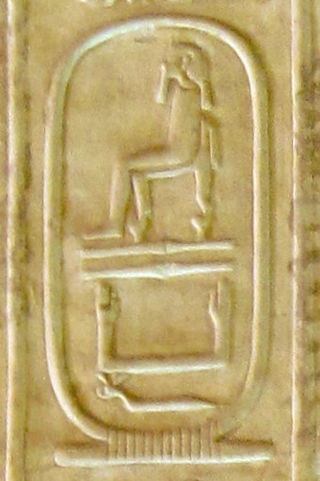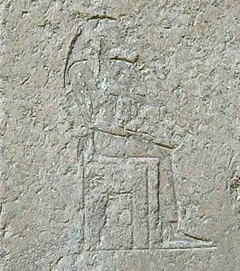| Bunefer in hieroglyphs | |||||
|---|---|---|---|---|---|
B(w)-nfr Bunefer | |||||

Bunefer was an ancient Egyptian queen from the 4th or 5th dynasty. It is not known which king she was married to. Bunefer was buried in tomb G 8408 in the Central Field of the Giza Necropolis.
| Bunefer in hieroglyphs | |||||
|---|---|---|---|---|---|
B(w)-nfr Bunefer | |||||

Bunefer was an ancient Egyptian queen from the 4th or 5th dynasty. It is not known which king she was married to. Bunefer was buried in tomb G 8408 in the Central Field of the Giza Necropolis.
Bunefer's titles were preserved in her tomb in Giza: King’s wife (ḥmt-nisw), Great one of the hetes-sceptre (wrt-hetes), Great one of the hetes-sceptre of the two ladies (wrt-hetes-nbti), She who sees Horus and Seth (m33t-ḥrw-stẖ), King’s wife, his beloved (ḥmt-nisw mryt.f), King’s daughter of his body (z3t-niswt-nt-ẖt.f), Priestess of Hathor (ḥmt-ntr-ḥwt-ḥrw), Priestess of Tjazepef (ḥmt-ntr-t3-zp.f), Priestess of the Horus Shepsesket (ḥmt-ntr-hrw-špss-ht), and Beloved and revered priestess of Shepses-nebti (ḥmt-ntr-špss-nbti-mryt.f-im3ḫt.f). [1]
Bunefer's titles as a priestess of Shepseskaf have led to the theory that Bunefer may have been a wife or daughter of Shepseskaf. [2] [3] Her tomb is located near the complex of Khentkaus I which further suggests she lived towards the end of the 4th or beginning of the 5th dynasty. It has also been suggested she was the wife of enigmatic king Thamphthis. [1]
Janosi has pointed out that the construction of Bunefer's tomb dates to some time after the tomb of Khentkaus was constructed. But the precise date of that monument is similarly not clear. It seems that Bunefer's tomb is more likely to date to the 5th dynasty however. [4]
Bunefer's rock-cut tomb is located to the north of the funerary complex of Queen Khentkaus I in the central field. The facade of the tomb opens to the south and a large doorway leads to a large chapel. Off to the east another doorway allows one to enter the tomb. Bunefer's name and titles appear on the walls and the pillars of the room. A son is mentioned in one of the scenes, but he has the simple titles of judge and inspector of the scribes. [5] The burial chamber of Bunefer contained a white limestone sarcophagus. Inside the sarcophagus a female skull was found of a woman estimated to be in her mid thirties. It is possible this is Queen Bunefer's skull. [1]

Hetepheres II was a Queen of Ancient Egypt during the 4th Dynasty.

The Fourth Dynasty of ancient Egypt is characterized as a "golden age" of the Old Kingdom of Egypt. Dynasty IV lasted from c. 2613 to 2494 BC. It was a time of peace and prosperity as well as one during which trade with other countries is documented.

Shepseskaf was a pharaoh of ancient Egypt, the sixth and probably last ruler of the fourth dynasty during the Old Kingdom period. He reigned most probably for four but possibly up to seven years in the late 26th to mid-25th century BC.

Khentkaus II was a royal woman who lived in Ancient Egypt. She was a wife of Egyptian king Neferirkare Kakai of the Fifth Dynasty. She was the mother of two kings, Neferefre and Nyuserre Ini.
Iput I was a Queen of Egypt, a daughter of King Unas, the last king of the Fifth Dynasty of Egypt. She married Teti, the first Pharaoh of the Sixth Dynasty of Egypt. Their son was Pepi I Meryre. She possibly ruled as regent for her son Pepi I.

Ankhesenpepi II or Ankhesenmeryre II was a queen consort during the Sixth Dynasty of Egypt. She was the wife of Kings Pepi I and Merenre Nemtyemsaf I, and the mother of Pepi II. She likely served as regent during the minority of her son. She was buried in a pyramid in Saqqara.
Neith was an ancient Egyptian queen consort, one of the principal queens of the Old Kingdom pharaoh Pepi II Neferkare, who ruled. Queen Neith was named after goddess Neith.
Meritites I was an ancient Egyptian queen of the 4th Dynasty. Her name means "Beloved of her Father". Several of her titles are known from a stela found at Giza. She was buried in the middle Queen’s Pyramid in Giza.
Khamerernebty I was an ancient Egyptian queen of the 4th dynasty. She was probably a wife of King Khafre and the mother of King Menkaure and Queen Khamerernebty II. It is possible that she was a daughter of Khufu, based on the fact that inscriptions identify her as a King's daughter.
Khamerernebty II was an ancient Egyptian queen of the 4th Dynasty. She was a daughter of Pharaoh Khafre and Queen Khamerernebty I. She married her brother Menkaure and she was the mother of Prince Khuenre.
Nubwenet was an ancient Egyptian queen consort, a wife of Pharaoh Pepi I of the 6th dynasty.
Nedjeftet is a queen mentioned on reliefs discovered near the pyramid complex of Pepi I. She was a wife of Pepi. Her name was also that of the 20th nome, later known as the Herakleopolis nome, in Upper Egypt; it is possible her family came from there and the marriage was to strengthen the king's position as opposed to the local lords.
Khuit II was a wife of King Teti, the first pharaoh of the Sixth Dynasty of Egypt.
Thamphthis is the hellenized name of an ancient Egyptian ruler (pharaoh) of the 4th Dynasty in the Old Kingdom, who may have ruled around 2500 BC under the name Djedefptah for between two and nine years. His original Egyptian name is lost, but it may have been Djedefptah or Ptahdjedef according to William C. Hayes. Thamphthis is one of the shadowy rulers of the Old Kingdom, since he is completely unattested in contemporary sources. For this reason, his historical figure is discussed intensely by historians and Egyptologists.

Meresankh II was a Queen of Egypt who lived during 4th Dynasty.

Khentkaus I, also referred to as Khentkawes, was a royal woman who lived in ancient Egypt during both the Fourth Dynasty and the Fifth Dynasty. She may have been a daughter of king Menkaure, the wife of both king Shepseskaf and king Userkaf, the mother of king Sahure. Some suggest that she was the regent for one of her sons. Perhaps, in her own right, she may have been the king of Upper and Lower Egypt, which aspects of her burial suggest. Her mastaba at Giza – tomb LG100 – is located very close to Menkaure's pyramid complex. This close connection may point to a family relationship. Although the relationship is not clear, the proximity of the pyramid complex of Khentkaus to that of king Menkaure has led to the conjecture that she may have been his daughter.
Meritites IV was a queen from the Sixth Dynasty. She was believed to be a wife of Pepi I Meryre, but her title of King’s Daughter of his body of Pepy-Mennefer (s3t-niswt-nt-kht.f-ppy-mn-nfr) is now understood to indicate that she was a daughter of Pepi I Meryre and wife of a king Neferkare, presumably Pepi II. One more evidence for that theory is that her name means "Beloved of her father".
Hekenuhedjet was an ancient Egyptian queen consort of the 4th Dynasty, a wife of pharaoh Khafre. She is depicted in the tomb of her son, the vizier Sekhemkare.
Nebet was an Egyptian Queen, the wife of King Unas. She lived during the time of the Fifth Dynasty of Egypt. She is held the mother of the Crown Prince Unas-ankh, though this fact is disputed. In addition to Unas Anch, Nebet may also be the mother of Khentkaues, Neferut, and Nefertkaues.
Khenut was the Queen of Egypt, the wife of King Unas. She lived during the time of the Fifth Dynasty of Egypt. She was a suspected mother of Queen Iput.